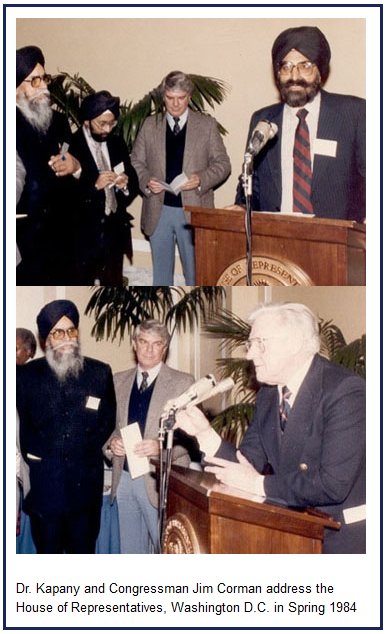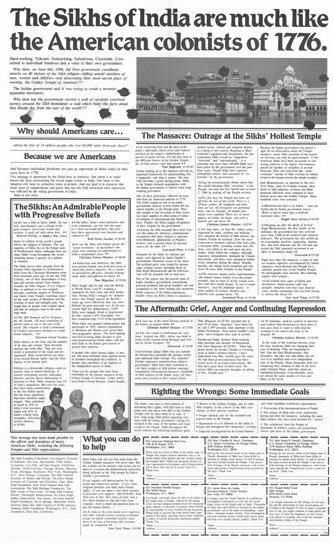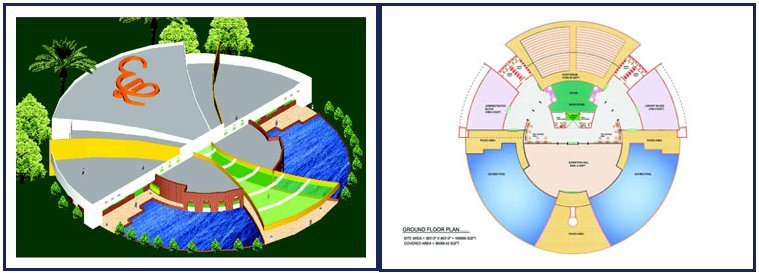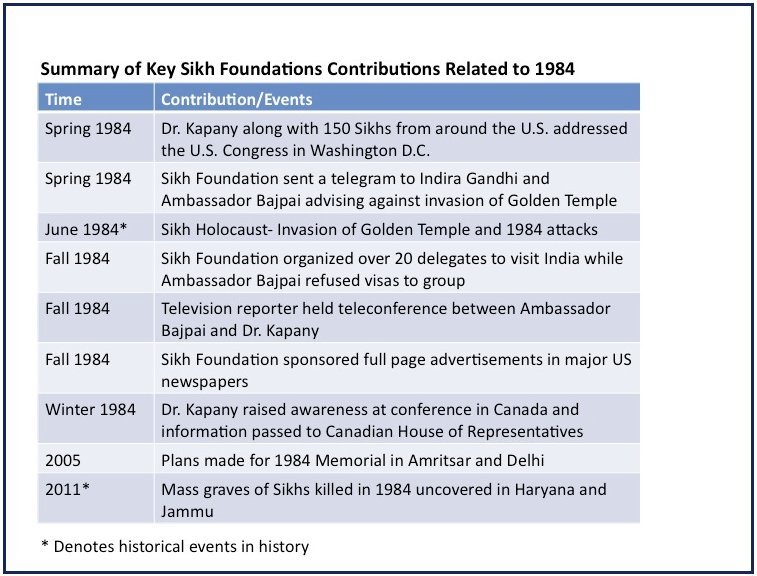“A community that forgets its martyrs falls into a constant decline and suffers from repeat persecution.”
 |
Dr. Kapany and Congressman Jim Corman address the House of Representatives, Washington D.C. in Spring 1984
On the anniversary of Operation Blue Star, the Sikh Foundation highlights the active role it has played over the last 27 years in helping to seek justice for those innocent people that lost their lives in the Sikh holocaust and making sure history never repeats itself.
The Sikh Foundation’s efforts began a few months before the 1984 attacks when a group of 150 Sikhs from all across the U.S. were invited to speak to the U.S. Congress in Washington D.C. about the impending danger in Punjab. The group collectively decided that Dr. Narinder S. Kapany, Chairman of the Sikh Foundation, should be the one to address the group of congressional leaders.
It was a profound moment in history where Kapany insightfully warned U.S. officials that “information gathered shows the government of India instructed by Indira Gandhi is getting ready to attack the Golden Temple and we strongly advise them not to do so, because if they do – it will be the beginning of the end!”
Following the proceedings, the Sikh Foundation sent a telegram to Indira Gandhi stating “the Golden Temple is under serious threat of being attacked by the government of India and we strongly urge you not to do such a thing.” To aid in the situation, the Sikh Foundation proposed that a group of Sikhs from the U.S. would come to Delhi and Punjab to pacify the situation and convince elected leaders that an operation like this should never be undertaken. A copy of this letter was sent to the capital, Washington D.C. to K. Shankar Bajpai, India’s ambassador to the U.S. However, no response was received….
Until a few short weeks later when the Indian government ordered the attack of the Golden Temple under Operation Blue Star and numerous other Sikh gurudwaras in Punjab and Delhi. A story that we all know too well, led to the massacre of thousands of innocent Sikhs in Punjab, Delhi, and across India. It was the darkest hour for the Sikhs. Here in the U.S., Sikhs were shocked, appalled and despite differing political viewpoints that often exist within the community, Sikhs all agreed and were in total opposition to the actions taken by the Indian government.
At that time Sikh Foundation arranged to fund over twenty congressional delegates including Sacramento Democrats Vic Fazio and Robert Matsui and former Republican representative Paul McCloskey. The panel was willing to travel to Delhi, meet with Prime Minister Indira Gandhi, and visit Punjab to speak with prominent Sikh leaders on the plight of their situation and changes that needed to take place, and come back to the U.S. and issue a report on their findings. As this trip was being organized, a letter of the proposed mission was sent to Ambassador Bajpai.
Bajpai responded forcefully saying “ no country, even a democracy, allows “self-constituted delegations from other countries to come and pry around in its domestic affairs” calling it an unwarranted intrusion into the internal affairs of India. Ambassador Bajpai denied the visas for the panel to come to India, thereby infuriating the Sikh community abroad.
After that incident, a local television journalist intervened and organized a well-received teleconference with Dr. Kapany and Ambassador Bajpai that was broadcasted around the country and educated Americans about the attacks of Sikhs and the atrocities committed by the Indian government. Bajpai said a “limited press censorship” had been imposed but “as normalcy returns, the political dialogue will be resumed.” Dr. Kapany brought light to the fact that Punjab had been “sealed off” for more than 10 weeks. “If there is nothing to hide, then why is it being hidden?” he asked. Full-page advertisement that appeared in major metropolitan newspapers in 1984
 |
| Full-page advertisement that appeared in major metropolitan newspapers in 1984 |
In an effort to educate more of the general public, Sikh Foundation helped raise over $50,000, a substantial amount of funds for this period in 1984, to print full page spreads in many major metropolitan newspapers including San Francisco, Los Angeles, New York, and Washington D.C. depicting the site of the Golden Temple with holes in it as a result of Operation Blue Star. It brought awareness to Americans about the 1984 attacks on Sikhs, going on in lands thousands of miles away. Through this, it inspired Americans to feel sympathy and concern for the deniable human rights and freedoms that their Sikh brothers and sisters faced, which was analogous to the suffering and hardship endured by Americans under their fight for freedom from the British government. The article included a call for duty to send messages of concern and aid to the addresses of the American Red Cross, U.S. Senate Committee on Foreign Affairs, U.S. President Ronald Reagan, Secretary-General of the United Nations, and the Punjab Relief Fund established by the Stockton Gurudwara.
In the wake of the attacks, Dr. Kapany gave a lecture in Vancouver while it was still very fresh in everyone’s minds. The talk was very well received to over a 1,000 people, and so much so that the speaker after him, a senior member of the Canadian House of Representatives felt so compelled by what he had heard, he forwarded a copy of Dr. Kapany’s speech to all of the members of the Canadian House of Representatives in Ottawa.
Now years later and withstanding all these efforts by many organizations including the Sikh Foundation, most Sikhs will tell you that the scars from the Golden Temple massacre will never heal, but the wounds can be dressed, and action can be taken to overcome the dehumanizing repression inflicted on the Sikh people. It’s for that reason when asked about his motivation after so many years of arduous effort that Dr. Kapany replies, “A community that forgets its martyrs falls into a constant decline and suffers from repeat persecution. You have to remember your own martyrs, and in our case, we had so many of them over the entire history of the Sikhs.”
Mass graves are still being found in present day in areas of Haryana and Jammu of Sikhs stoned alive, killed and buried by mobs in 1984.
Until there is justice, the Sikh Foundation will continue its mission. Several years ago, the Foundation spearheaded efforts to formalize magnificent plans and sketches for a monument to the Sikh martyrs to be constructed in Delhi and Amritsar. The vision was to have a museum of the Sikhs, a modern, high-tech library with computers, and a cultural center where Sikhs and non-Sikhs would have a place to discuss matters of interest to Sikhs. Not surprisingly, when presenting the idea of the monument to senior officials of the Indian government and also to a number of wealthy Sikhs residing in Delhi, the project was halted dead in its tracks.

Nonetheless, the Sikh Foundation continues to play an active role in remembering the Sikh martyrs of 1984. The Sikh Foundation has teamed up with artist Devinder Singh of India to portray the lives of Sikh martyrs and families affected by 1984 that will be represented in an upcoming Sikh Arts calendar.
While many contributions have been made over the last 27 years, the Sikh Foundation will continue to carry on and play an active duty in making sure those who lost their lives in 1984 will never be forgotten and will be forever etched in our hearts and memories.


